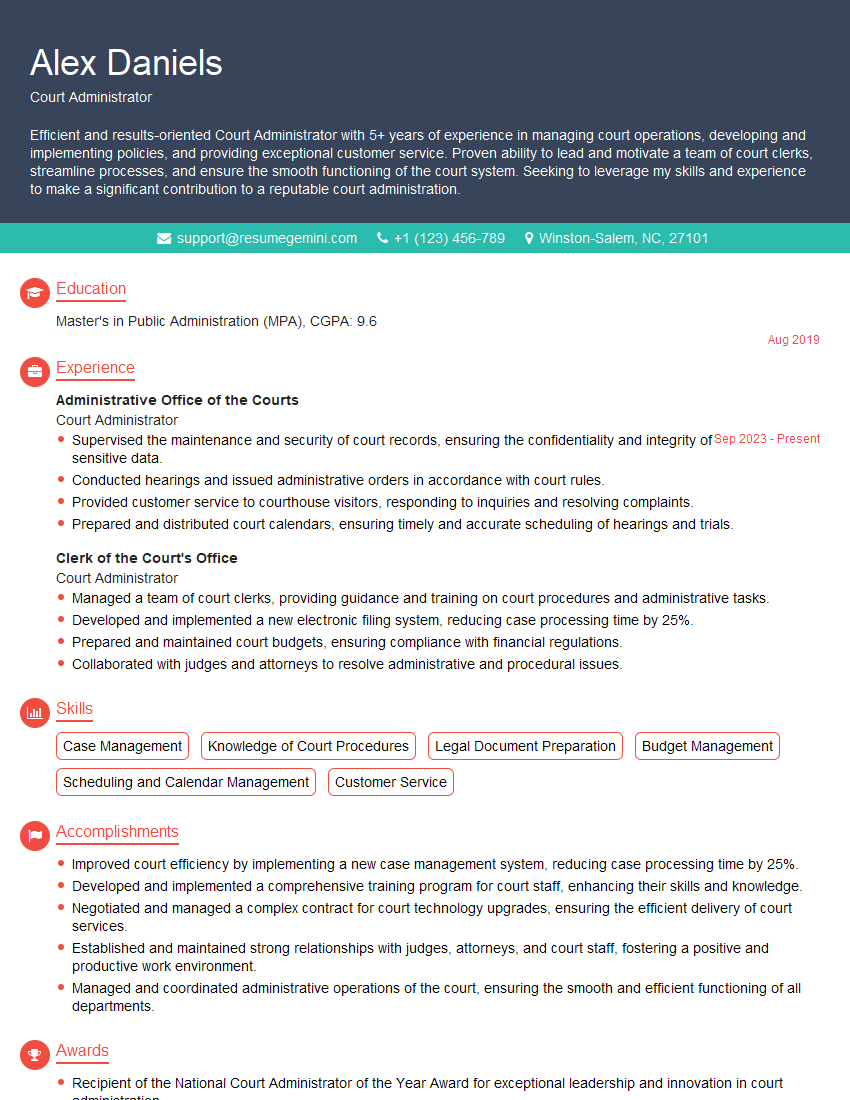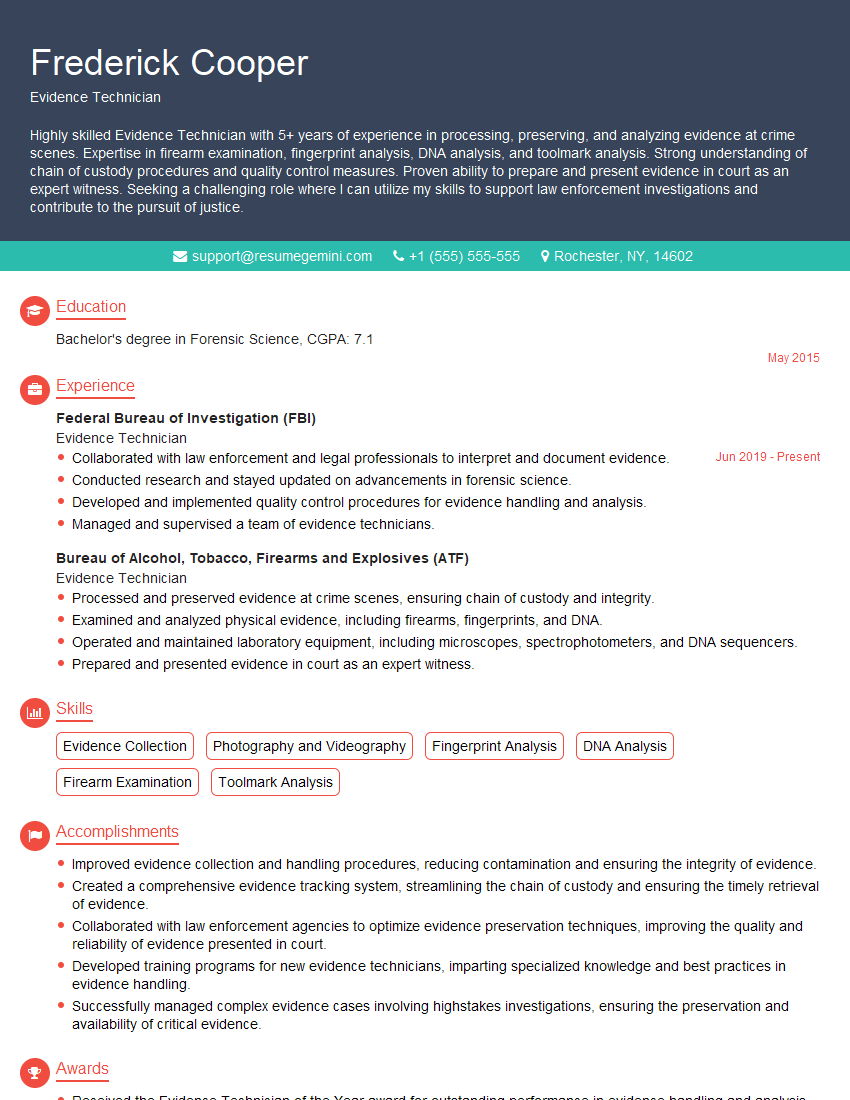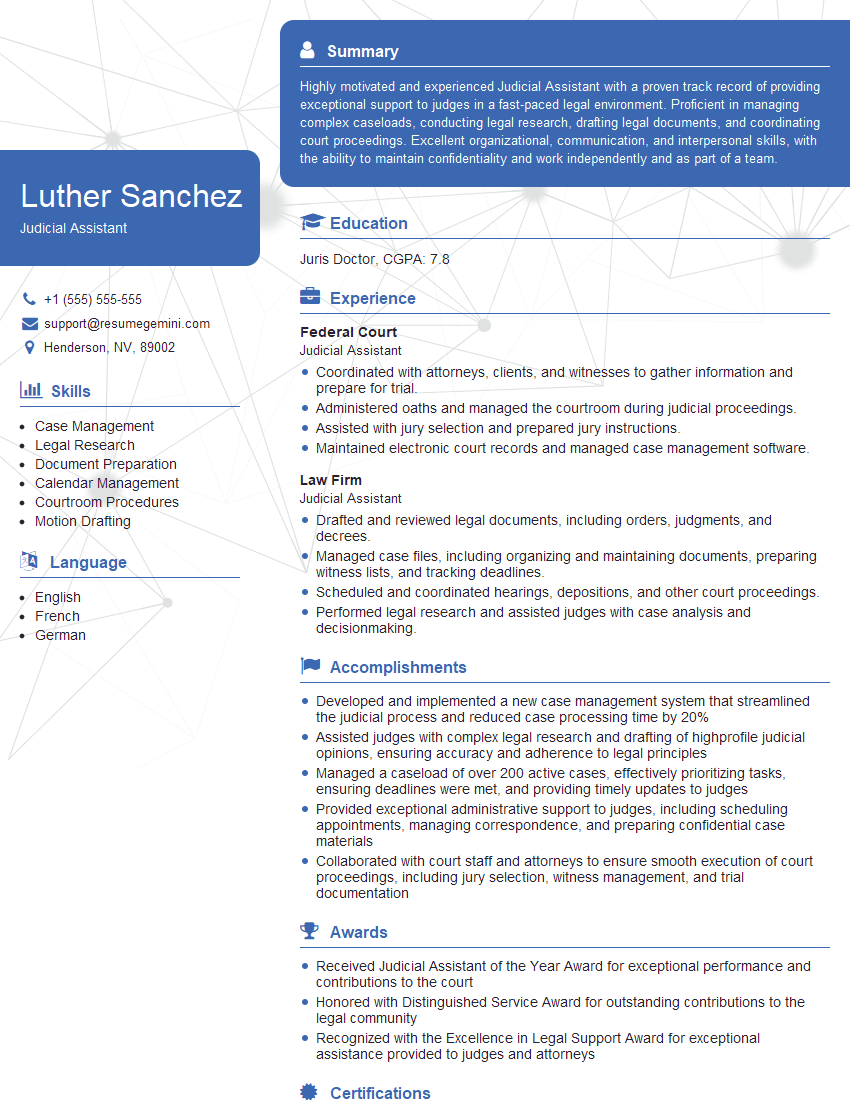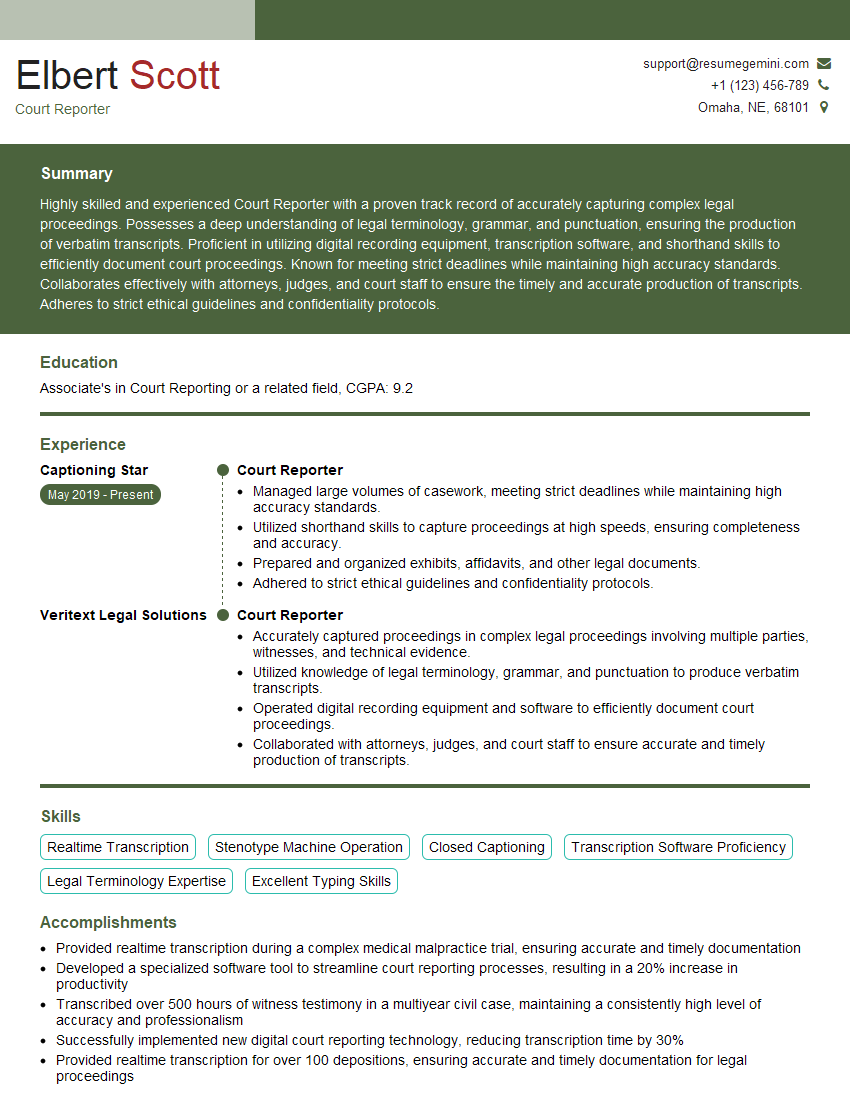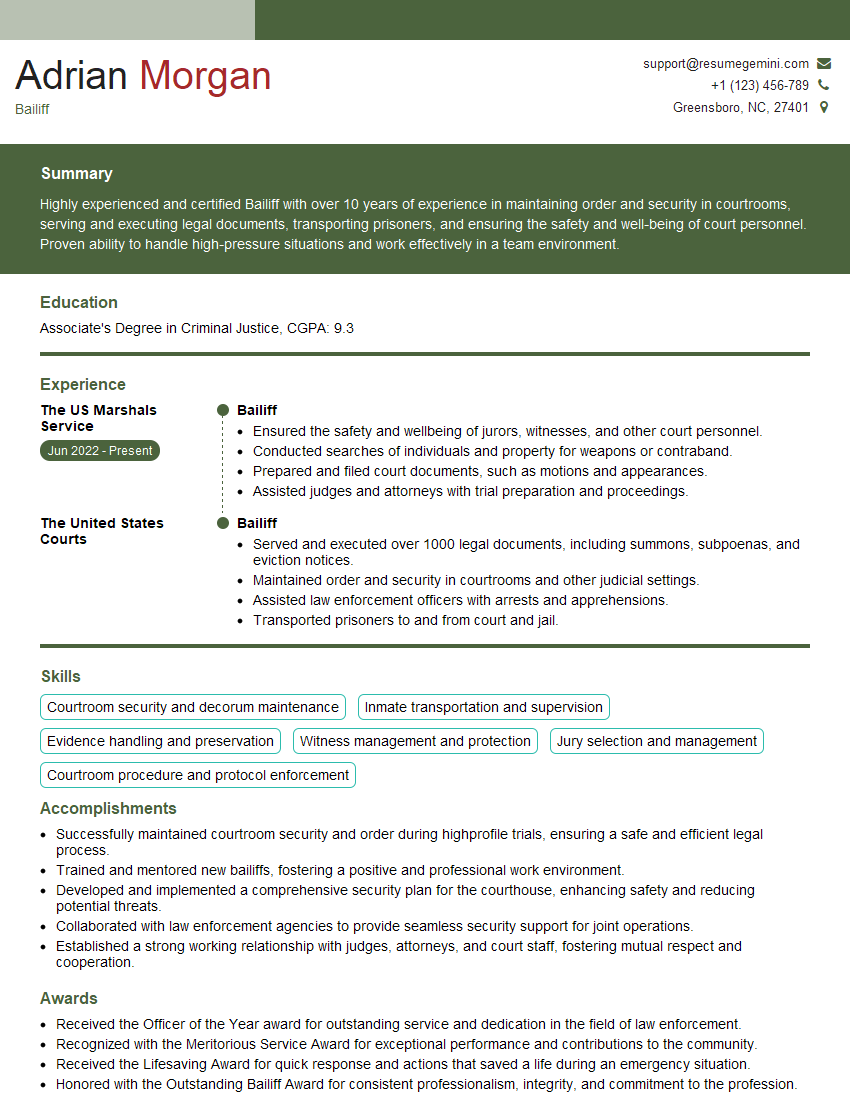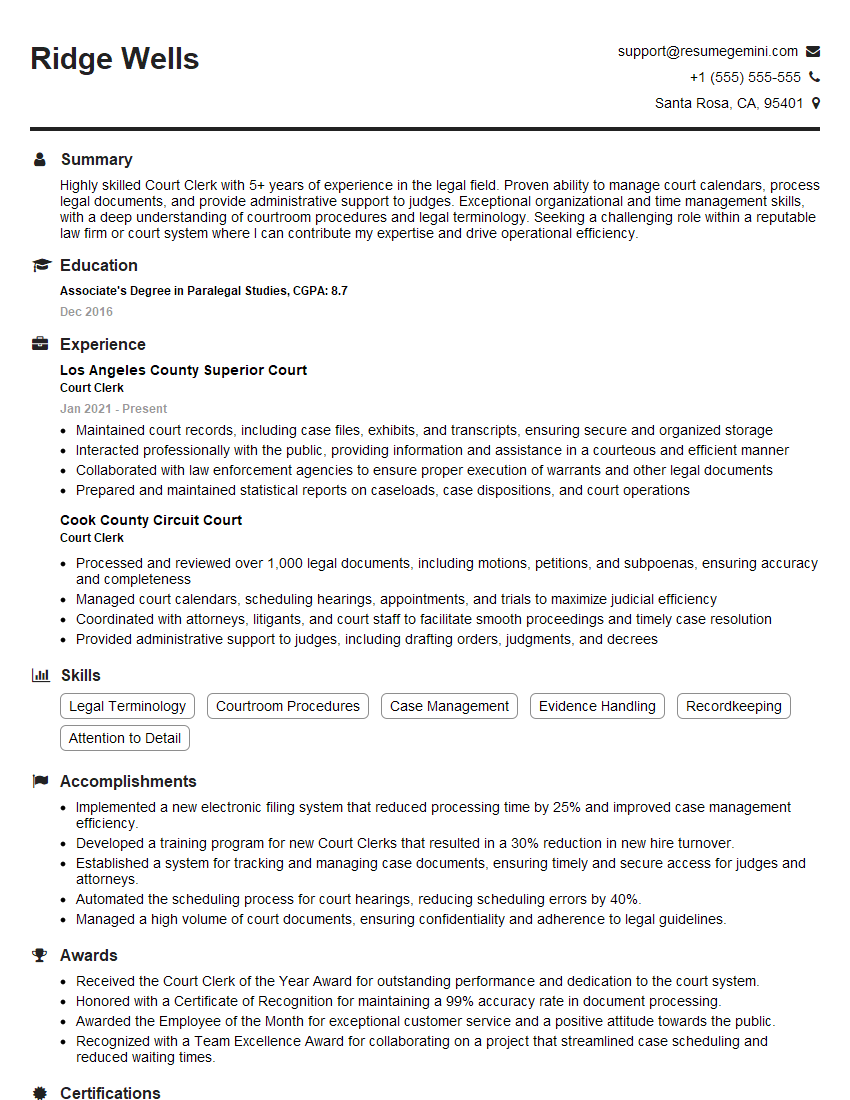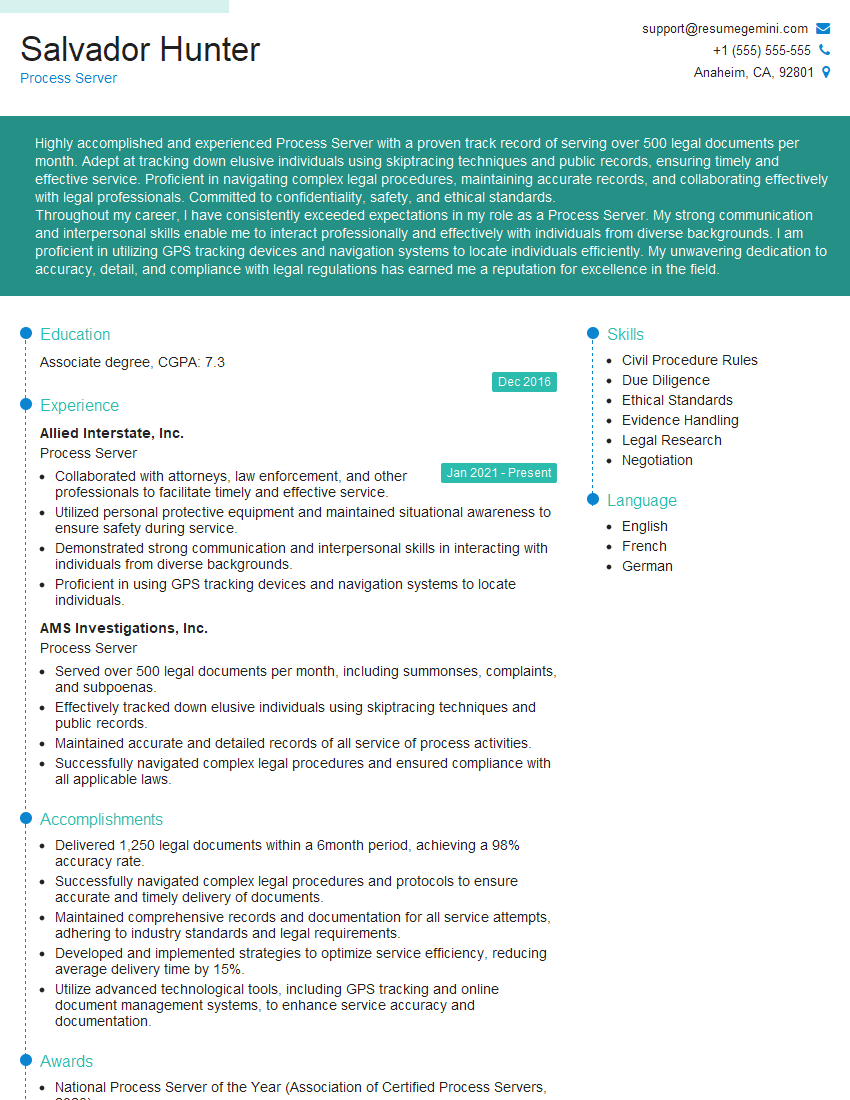Interviews are more than just a Q&A session—they’re a chance to prove your worth. This blog dives into essential Understanding of Courtroom Etiquette interview questions and expert tips to help you align your answers with what hiring managers are looking for. Start preparing to shine!
Questions Asked in Understanding of Courtroom Etiquette Interview
Q 1. Define ‘subpoena’ and explain the proper procedure for handling one.
A subpoena is a legal document that compels someone to appear in court to testify or produce evidence. Think of it as a court order you must obey. Ignoring a subpoena can lead to serious consequences, including fines or even arrest.
The proper procedure for handling a subpoena involves several steps:
- Read it carefully: Understand what the subpoena requires – your testimony, documents, or both. Note the date, time, and location of the court appearance.
- Contact legal counsel: If you’re unsure about anything, immediately seek advice from a lawyer. They can explain your rights and obligations and advise you on the best course of action. This is crucial, especially if the subpoena requests sensitive information or if you believe it’s improperly served.
- Respond promptly: Subpoenas usually have a deadline for response. Failure to respond within the specified timeframe can result in penalties.
- Appear in court (or provide requested documents): If you’re summoned to testify, be prepared to answer questions truthfully and accurately. If you’re required to produce documents, ensure they are organized and readily accessible.
- Keep records: Maintain copies of the subpoena, your response, and any related correspondence. This documentation is vital for your protection.
Example: Imagine you receive a subpoena to testify about a car accident you witnessed. You should carefully read the subpoena, contact your lawyer (if you have one), and prepare to provide a truthful account of the events.
Q 2. Describe the proper attire for appearing in a courtroom.
Courtroom attire should always be respectful and conservative. Think ‘business professional’ but slightly elevated. The goal is to demonstrate respect for the court and the legal process.
For men, this typically means a suit (dark-colored is preferred), a dress shirt, a tie, and dress shoes. For women, a pantsuit, skirt suit, or a dress (knee-length or longer) paired with a blazer and modest shoes is appropriate. Avoid anything too casual, revealing, or flashy. Think of it like attending an important job interview – you want to project professionalism and seriousness.
Things to avoid: Jeans, t-shirts, shorts, flip-flops, hats (unless for religious reasons), and overly revealing clothing. Strong perfumes or colognes should also be avoided as they can be distracting to others in the courtroom.
Example: While a perfectly acceptable outfit for a casual Friday at the office might be jeans and a nice sweater, this is decidedly inappropriate for a courtroom appearance.
Q 3. Explain the significance of maintaining respectful silence in a courtroom.
Maintaining respectful silence in a courtroom is paramount because it ensures the orderly conduct of legal proceedings. Courtrooms are places where serious matters are being discussed and decisions are being made that impact people’s lives. Noise and disruption undermine the gravity of the situation and can hinder the judge’s ability to hear and rule on the case.
Silence also shows respect for the judge, the attorneys, witnesses, jurors, and other individuals involved in the process. It allows everyone to concentrate, facilitating a fair and efficient hearing. Disrespectful behavior can result in consequences, ranging from a warning from the bailiff to being held in contempt of court.
Example: Whispering to your neighbor, using your phone, or laughing loudly would be considered disruptive and disrespectful in a courtroom. Remember, you are participating in a formal and serious legal setting.
Q 4. How should you address a judge in court?
You should address a judge formally, using ‘Your Honor’ or ‘Judge [Judge’s last name]’. It’s essential to be respectful and polite in all your interactions with the judge. Direct eye contact when speaking to the judge shows respect and confidence. Never interrupt the judge. If you need to speak, wait for your opportunity. A calm and respectful demeanor will always be viewed favorably.
Example: Instead of saying ‘Hey Judge, can I ask something?’, you should address the judge by saying, ‘Your Honor, may I ask a question?’
Q 5. What is the proper procedure for submitting evidence in court?
Submitting evidence in court is a formal process. Evidence is usually presented through witnesses or as exhibits (physical items). Before submitting any evidence, you should usually have already disclosed it to the opposing counsel. The process usually involves a chain of custody to ensure the evidence’s integrity. The judge will determine the admissibility of the evidence based on established rules of evidence.
Steps typically involved:
- Identification of the evidence: The attorney will clearly identify the evidence to the judge and opposing counsel.
- Marking for identification: The court clerk or bailiff will mark the evidence with a number or letter for identification purposes.
- Foundation for admissibility: The attorney will lay the foundation for admissibility by establishing its authenticity, relevance, and reliability.
- Objection from opposing counsel: Opposing counsel may object to the admissibility of the evidence, and the judge will rule on the objection.
- Formal presentation: Once admitted, the evidence is formally presented to the judge and jury (if there is one).
Example: A photograph of the crime scene needs to be properly authenticated (someone must testify that they took the picture and that it accurately depicts the scene) before it can be admitted as evidence.
Q 6. How should you conduct yourself during a court recess?
During a court recess, you should remain respectful and avoid any actions that could be construed as disruptive or disrespectful. This means refraining from loud conversations, using electronic devices, or engaging in inappropriate behavior. You should maintain a professional demeanor and avoid discussing the case with anyone other than your attorney or designated representatives. The recess is a time to collect your thoughts, relax briefly, and prepare for the next phase of the proceedings, but it’s still considered part of the courtroom setting.
Example: Instead of engaging in loud laughter with friends, you should quietly wait your turn and maintain a professional composure.
Q 7. What is the role of a bailiff?
The bailiff is a court officer responsible for maintaining order and security in the courtroom. They are essentially the ‘police’ of the court. Their duties include:
- Maintaining order: Ensuring everyone in the courtroom behaves appropriately and respects the legal process.
- Security: Protecting the judge, jurors, witnesses, and other court personnel from harm or threats.
- Swearing in witnesses: Administering oaths to witnesses before they testify.
- Handling evidence: Sometimes responsible for handling and securing physical evidence.
- Announcing the judge’s arrival and departure: Maintaining a level of formality and respect for the judge.
- Managing courtroom traffic: Ensuring orderly movement of people within the courtroom.
Bailiffs play a vital role in ensuring the smooth and efficient operation of the court.
Q 8. Explain the difference between direct and cross-examination.
Direct and cross-examination are two distinct phases of questioning a witness in court. Direct examination is when the attorney who called the witness to the stand questions them. The goal is to present the witness’s testimony in a favorable light, building the attorney’s case. This involves open-ended questions designed to elicit narrative responses. In contrast, cross-examination is conducted by the opposing attorney. The purpose here is to challenge the witness’s testimony, highlight inconsistencies, or discredit their credibility. Cross-examination typically employs more pointed, closed-ended questions that limit the witness’s ability to elaborate.
Example: Imagine a witness testifying about a car accident. During direct examination, the attorney might ask, “Can you describe what you saw leading up to the accident?” During cross-examination, the opposing attorney might ask, “Did you see the stop sign before the intersection? Yes or no?” The difference is clear: one is designed to build a narrative, the other to test the narrative’s accuracy and reliability.
Q 9. Describe the procedures for objecting to a line of questioning.
Objecting to a line of questioning is a crucial aspect of courtroom procedure. When an attorney believes a question is improper—for example, if it calls for speculation, is leading, or is irrelevant—they can object. The objection must be stated clearly and concisely, usually with the specific grounds for the objection. For instance, an attorney might say, “Objection, calls for speculation,” or “Objection, leading.”
The judge then rules on the objection. If the judge sustains the objection, the question is disallowed. If the judge overrules the objection, the witness must answer. It’s important to remember that objections should be made promptly and only when genuinely necessary. Overuse or frivolous objections can annoy the judge and harm the credibility of the objecting attorney. Think of objections as a tool to maintain the integrity and fairness of the legal process, not as a weapon for disruption.
Q 10. What are the consequences of disruptive behavior in a courtroom?
Disruptive behavior in a courtroom undermines the judicial process and can have serious consequences. This ranges from outbursts and disrespectful comments to refusing to follow court orders. The consequences can vary greatly depending on the severity of the disruption and the judge’s discretion. These penalties can include:
- Verbal warnings: A judge might issue a warning to cease the disruptive behavior.
- Contempt of court: More serious disruptions can lead to a finding of contempt of court, which can result in fines or even jail time.
- Removal from the courtroom: The judge might order the disruptive individual to leave the courtroom for the remainder of the proceedings.
- Sanctions against attorneys: If an attorney’s conduct is disruptive, the judge might impose sanctions, such as reprimands or fines.
In essence, maintaining decorum is paramount. Courtrooms are places where justice is sought and delivered; disruptions detract from this essential function. Understanding and adhering to courtroom decorum shows respect for the court, the judge, and the legal process.
Q 11. How should you respond to a judge’s question?
Responding to a judge’s question requires utmost respect and careful consideration. You should answer truthfully, concisely, and respectfully. It’s vital to avoid being argumentative or evasive. Always maintain eye contact with the judge, and speak clearly and audibly. If you don’t understand the question, politely request clarification. Never interrupt the judge.
Think of it this way: the judge is the ultimate authority in the courtroom. Your response should demonstrate your awareness of this authority and your commitment to the proper functioning of the court. A respectful and straightforward answer is always the best approach. Imagine answering a judge’s question with the same level of politeness and attention to detail as you would when addressing a respected elder or authority figure outside of the courtroom. That same level of consideration is expected within the court setting.
Q 12. Explain the importance of maintaining objectivity in the courtroom.
Objectivity is crucial in the courtroom to ensure fairness and impartiality. This means avoiding personal biases, emotions, and preconceived notions when presenting evidence, examining witnesses, or making arguments. Maintaining objectivity protects the integrity of the legal process. Subjectivity can lead to inaccurate judgments or unfair outcomes. A lawyer, for example, should aim to present facts accurately, even if those facts don’t support their case, and should avoid manipulating evidence or twisting the truth to gain an advantage. In essence, the legal system relies on impartial assessments to ensure the just application of the law, making objectivity a cornerstone of effective legal representation.
Q 13. What is the proper way to address a witness?
Addressing a witness requires politeness and formality. Typically, you should address a witness as “Mr./Ms./Mx. [Last Name]” unless the judge or the witness themselves indicate otherwise. Avoid using first names unless explicitly invited to do so. This level of formality maintains a professional atmosphere and shows due respect for the individual and the judicial process. Remember, the courtroom setting demands a degree of formality; maintaining that decorum is a sign of respect for all involved and a fundamental element of maintaining order.
Q 14. What are your responsibilities as a legal professional in maintaining order in the courtroom?
As a legal professional, maintaining order in the courtroom is a shared responsibility. This involves adhering to courtroom etiquette, controlling your own behavior, and ensuring your clients also behave appropriately. This includes speaking respectfully to the judge, court staff, opposing counsel, and witnesses. It also means instructing your clients on proper courtroom conduct. Furthermore, it extends to managing any disruptive behavior from your client or associates—addressing any issues promptly and quietly before it escalates. If you witness disruptions from others, you have a duty to bring them to the judge’s attention appropriately. You are, after all, an officer of the court and your conduct is as crucial to the effective administration of justice as the judge’s.
Q 15. How should you handle an unexpected disruption in the proceedings?
Handling unexpected disruptions requires a calm and professional demeanor. The first step is to assess the nature of the disruption. Is it a technical malfunction, a medical emergency, or a disruptive individual? Once assessed, alert the judge immediately, but do so quietly and respectfully. Avoid drawing undue attention to the disruption unless absolutely necessary. For instance, if a fire alarm goes off, calmly follow the evacuation procedures. If a witness faints, quietly signal court staff for assistance. The key is to maintain order and allow the judge to manage the situation.
Example: Imagine a power outage during testimony. Instead of panicking, calmly inform the court officer, who will then inform the judge. The judge will then decide the appropriate course of action, which might include a recess or adjournment.
Career Expert Tips:
- Ace those interviews! Prepare effectively by reviewing the Top 50 Most Common Interview Questions on ResumeGemini.
- Navigate your job search with confidence! Explore a wide range of Career Tips on ResumeGemini. Learn about common challenges and recommendations to overcome them.
- Craft the perfect resume! Master the Art of Resume Writing with ResumeGemini’s guide. Showcase your unique qualifications and achievements effectively.
- Don’t miss out on holiday savings! Build your dream resume with ResumeGemini’s ATS optimized templates.
Q 16. What is the proper procedure for requesting a postponement?
Requesting a postponement requires a formal and well-justified request. You typically need to submit a motion to the court outlining the reasons for the postponement, providing supporting documentation if necessary. This might include medical certificates, scheduling conflicts, or unavailability of key witnesses. The motion should be filed well in advance of the scheduled date, providing ample time for the judge to review and rule on the request. Be prepared to explain your reasoning clearly and concisely to the court.
Example: A lawyer might request a postponement due to a key witness’s unexpected hospitalization. They would file a motion, including a doctor’s note as supporting evidence, explaining how the witness’s absence would significantly impact the case and requesting a new date.
Q 17. Explain the concept of ‘contempt of court’.
Contempt of court refers to any action that shows disrespect or defiance towards the authority of the court. This can range from minor offenses, like talking during proceedings, to more serious ones, such as refusing to testify or obstructing justice. The consequences can vary depending on the severity of the offense, ranging from fines to imprisonment. Essentially, it’s about maintaining the integrity and respect of the legal system.
Examples: Refusing to answer a direct question from the judge, making inappropriate comments in the courtroom, or deliberately destroying evidence are all examples of contempt of court.
Q 18. How would you handle a situation where a witness becomes unresponsive?
If a witness becomes unresponsive, the first step is to assess the situation. Is the witness experiencing a medical emergency? Are they simply nervous or intimidated? If a medical emergency is suspected, immediately call for medical assistance. If the witness appears nervous, a brief pause might help. The attorney should address the witness calmly and respectfully, attempting to re-establish communication. The judge should be informed of the situation so they can guide the process. In extreme cases, a recess might be necessary.
Example: If a witness becomes tearful during testimony, the attorney might politely ask if they need a moment to compose themselves, providing a brief break before resuming the questioning.
Q 19. What are the ethical considerations for professionals in a courtroom setting?
Ethical considerations in a courtroom setting are paramount. All professionals, including lawyers, judges, court staff, and witnesses, must uphold the highest standards of honesty, integrity, and fairness. This includes avoiding conflicts of interest, protecting client confidentiality, ensuring accurate representation of facts, and treating all participants with respect, regardless of their role. A breach of ethics can have serious consequences, ranging from professional sanctions to criminal charges.
Example: A lawyer cannot knowingly present false evidence or withhold exculpatory evidence from the court. This is a serious breach of ethical conduct with potentially severe consequences.
Q 20. What is the importance of proper note-taking during court proceedings?
Proper note-taking during court proceedings is crucial for accurate record-keeping and effective legal work. Notes provide a detailed record of testimony, evidence presented, and rulings made. This is invaluable during case preparation, legal strategy, and even appeal processes. Clear, concise, and organized note-taking ensures that important details are captured accurately and can be easily referenced later.
Example: Accurate notes might include witness names, dates, specific times, and key details from testimony or evidence presented. These notes serve as a valuable resource during the preparation of briefs, legal arguments, and cross-examination.
Q 21. How would you manage a situation with a disruptive spectator?
Managing a disruptive spectator involves a multi-step approach. First, assess the nature and severity of the disruption. Is it verbal, physical, or otherwise threatening? Secondly, attempt to quietly address the individual, reminding them of appropriate courtroom behavior. If this is ineffective, alert the court officer or bailiff. They have the authority to intervene and ensure order in the courtroom. In serious situations, the judge might be involved, potentially leading to removal from the courtroom or even contempt of court charges.
Example: If a spectator is loudly whispering comments during testimony, a court officer can be alerted to quietly address the situation. If the behavior continues, the judge might issue a warning or order removal from the courtroom.
Q 22. How do you ensure your conduct upholds the integrity of the court?
Upholding the integrity of the court hinges on demonstrating respect for the judicial process, the judge, the jury, opposing counsel, witnesses, and all court personnel. This means adhering strictly to the rules of professional conduct and courtroom etiquette at all times. It’s about ensuring the proceedings are fair, impartial, and efficient.
- Respectful Demeanor: Maintaining a calm, professional demeanor, avoiding interrupting others, and addressing the judge as ‘Your Honor’ are fundamental. Imagine a doctor’s office – you wouldn’t be disruptive, and court requires a similar level of deference.
- Truthfulness and Honesty: Presenting arguments and evidence honestly and ethically is paramount. Fabricating evidence or misleading the court severely undermines its integrity. Think of it as a foundation – a court’s decisions rely on a trustworthy base of facts.
- Proper Attire: Dressing professionally demonstrates respect for the court. Appropriate business attire is expected; think of it as showing up for a significant job interview, reflecting the seriousness of the situation.
- Following Procedures: Adhering to all court rules and procedures, including deadlines for filings and evidence submission, is critical. These procedures are the guidelines ensuring a smooth legal process.
Q 23. What is the importance of being aware of courtroom technology and its use?
Familiarity with courtroom technology is no longer optional; it’s essential for efficient and effective participation. Many courts utilize electronic filing systems, video conferencing, and digital evidence presentation. Lack of proficiency can lead to delays, misunderstandings, and even procedural errors.
- Electronic Filing: Knowing how to submit documents electronically, adhering to court-specific formatting requirements, and managing electronic signatures is crucial. For instance, a missed deadline due to unfamiliarity with the e-filing system could have severe consequences.
- Video Conferencing: Understanding how to use video conferencing technology for depositions, hearings, or even trials is important for remote participation. Technical glitches can disrupt proceedings, so preparation is key.
- Digital Evidence Presentation: Courts increasingly rely on digital evidence. Being able to effectively present and manage this evidence, from images to complex data sets, is vital for a successful case.
Q 24. Explain the significance of maintaining confidentiality in court-related matters.
Maintaining confidentiality in court-related matters is paramount for several reasons: it protects the privacy of individuals involved, preserves the integrity of the judicial process, and ensures fairness in the proceedings. Disclosing confidential information can lead to legal sanctions and damage the reputation of all involved.
- Client Confidentiality: Attorneys have a strict ethical obligation to protect client confidentiality, including sensitive personal information, financial details, and case strategies. Breaching this trust can lead to disciplinary action and lawsuits.
- Witness Confidentiality: Protecting witness identities and information can be crucial, especially in cases involving vulnerable individuals or national security. Public disclosure might place witnesses in danger or prejudice the case.
- Pre-Trial Information: Confidential information exchanged during discovery or negotiations is protected to ensure a fair trial. Public disclosure could compromise the case and lead to unfair advantages for one side.
Q 25. What are the procedures for handling confidential documents in court?
Handling confidential documents requires strict adherence to court rules and best practices. This typically involves secure storage, restricted access, and proper disposal methods.
- Secure Storage: Confidential documents should be stored in locked cabinets or secure electronic systems with access limited to authorized personnel. Think of it like a bank vault – strict protocols limit who can access sensitive information.
- Restricted Access: Only authorized individuals, such as the judge, attorneys, and court staff with a need to know, should have access to confidential documents. Access logs and tracking systems can help maintain accountability.
- Secure Disposal: Confidential documents should be securely destroyed upon completion of the case using methods like shredding or secure electronic deletion. Improper disposal could lead to sensitive information falling into the wrong hands.
- Redaction and Anonymization: When sharing documents, sensitive information such as names, addresses, or social security numbers should be redacted or anonymized to protect privacy.
Q 26. Describe the proper use of electronic devices in a courtroom.
The use of electronic devices in a courtroom is strictly regulated to ensure the integrity of the proceedings and prevent disruptions. Generally, the use of cell phones, laptops, and other devices is restricted, unless specifically permitted by the judge.
- No Cell Phones (Typically): Cell phones are usually prohibited to prevent recording, distractions, and potential disruptions. Think of it as a respectful silent setting for focused proceedings.
- Laptops for Attorneys: Attorneys may be allowed to use laptops for note-taking or accessing case files, but only with the judge’s permission. This typically requires notifying the court beforehand.
- No Recording Devices: Unless explicitly authorized, recording devices are strictly prohibited. Such recordings could be used to manipulate proceedings or compromise witness testimony.
- Always Check with the Court: Before bringing any electronic device, it’s crucial to check the court’s specific policies to avoid violations and potential sanctions.
Q 27. How do you handle sensitive or emotional testimony?
Handling sensitive or emotional testimony requires sensitivity, empathy, and professionalism. The goal is to create a supportive environment while ensuring the integrity of the legal process.
- Empathetic Approach: Attorneys and court personnel should approach witnesses with sensitivity and understanding, recognizing the emotional toll of testifying. Patience and clear communication are crucial.
- Breaks if Needed: If a witness becomes overwhelmed, the judge may grant breaks to allow them to compose themselves. Attorneys should be mindful of a witness’ emotional state and suggest breaks when necessary.
- Respectful Questioning: Attorneys should frame questions in a way that avoids further trauma or distress. Avoiding leading questions or confrontational questioning is critical.
- Maintaining Order: While showing empathy, it’s equally important to ensure that the proceedings remain orderly and respectful. The courtroom is not a therapy session; it’s a place of legal proceedings.
Q 28. How would you ensure the efficient flow of proceedings within courtroom etiquette guidelines?
Ensuring efficient courtroom proceedings while adhering to etiquette requires preparation, clear communication, and a focus on the case’s objectives.
- Preparedness: All parties must come prepared, having reviewed documents, organized evidence, and prepared questions. Wasting court time due to lack of preparedness is unacceptable.
- Clear Communication: Attorneys should articulate their points clearly, concisely, and respectfully, avoiding unnecessary interruptions or arguments. Think of it like a well-rehearsed play; each party should know their role and execute it efficiently.
- Respect for Time: Attorneys should be mindful of the court’s schedule and avoid unnecessary delays. Respect for the judge’s time and the time of others involved is crucial.
- Professional Conduct: Maintaining professional conduct throughout the proceedings, including respecting the judge’s rulings and avoiding personal attacks, is essential for efficiency and preventing disruption.
Key Topics to Learn for Understanding of Courtroom Etiquette Interview
- Respect for the Court: Understanding the hierarchical structure of the courtroom and demonstrating appropriate deference to judges, attorneys, and court staff. Practical application: Knowing when and how to address individuals within the courtroom setting.
- Professional Attire and Demeanor: Maintaining a professional appearance and exhibiting respectful and composed behavior throughout your time in the courtroom. Practical application: Choosing appropriate clothing and avoiding distracting behaviors such as excessive talking or fidgeting.
- Proper Communication: Speaking clearly and concisely, avoiding interruptions, and adhering to instructions from court personnel. Practical application: Knowing how to respectfully address questions posed by the judge or attorneys.
- Evidence Handling and Procedures: Understanding the proper procedures for handling and presenting evidence, including chain of custody and authentication. Practical application: Knowing the protocols for handling sensitive or confidential materials within the court setting.
- Rules of Evidence and Procedure: Familiarity with fundamental rules of evidence and courtroom procedure, such as objections and motions. Practical application: Understanding the basis for common objections and their implications for testimony and evidence presentation.
- Maintaining Confidentiality: Recognizing and respecting the confidential nature of court proceedings and related information. Practical application: Understanding and adhering to confidentiality agreements and protocols.
- Ethical Conduct: Adhering to the highest ethical standards and avoiding any actions that could compromise the integrity of the legal process. Practical application: Understanding and avoiding conflicts of interest.
Next Steps
Mastering courtroom etiquette is crucial for career advancement in any legal field. It demonstrates professionalism, respect, and a commitment to ethical conduct – qualities highly valued by employers. To significantly enhance your job prospects, create an ATS-friendly resume that effectively highlights your skills and experience. ResumeGemini is a trusted resource that can help you build a powerful, professional resume tailored to your specific career goals. We provide examples of resumes tailored to showcase expertise in Understanding of Courtroom Etiquette, allowing you to present yourself as the ideal candidate.
Explore more articles
Users Rating of Our Blogs
Share Your Experience
We value your feedback! Please rate our content and share your thoughts (optional).
What Readers Say About Our Blog
Interesting Article, I liked the depth of knowledge you’ve shared.
Helpful, thanks for sharing.
Hi, I represent a social media marketing agency and liked your blog
Hi, I represent an SEO company that specialises in getting you AI citations and higher rankings on Google. I’d like to offer you a 100% free SEO audit for your website. Would you be interested?
